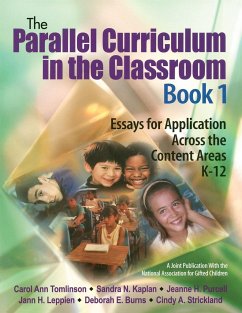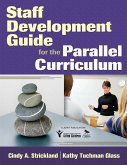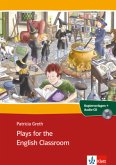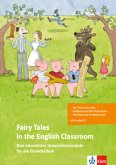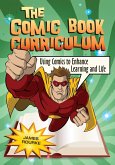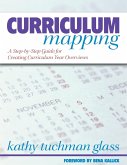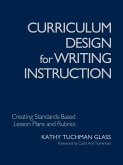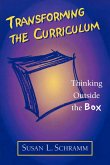Carol Ann Tomlinson, Sandra N Kaplan
The Parallel Curriculum in the Classroom, Book 1
Essays for Application Across the Content Areas, K-12
Carol Ann Tomlinson, Sandra N Kaplan
The Parallel Curriculum in the Classroom, Book 1
Essays for Application Across the Content Areas, K-12
- Broschiertes Buch
- Merkliste
- Auf die Merkliste
- Bewerten Bewerten
- Teilen
- Produkt teilen
- Produkterinnerung
- Produkterinnerung
Further developing key ideas from the highly acclaimed original book, these essays include guidelines for designing curriculum units based on the Parallel Curriculum Model.
Andere Kunden interessierten sich auch für
![Staff Development Guide for the Parallel Curriculum Staff Development Guide for the Parallel Curriculum]() Cindy A StricklandStaff Development Guide for the Parallel Curriculum41,99 €
Cindy A StricklandStaff Development Guide for the Parallel Curriculum41,99 €![Plays for the English Classroom, m. Audio-CD Plays for the English Classroom, m. Audio-CD]() Patricia GrethPlays for the English Classroom, m. Audio-CD19,80 €
Patricia GrethPlays for the English Classroom, m. Audio-CD19,80 €![Fairy Tales in the English Classroom, m. Audio-CD Fairy Tales in the English Classroom, m. Audio-CD]() Carola LurtzFairy Tales in the English Classroom, m. Audio-CD23,80 €
Carola LurtzFairy Tales in the English Classroom, m. Audio-CD23,80 €![The Comic Book Curriculum The Comic Book Curriculum]() James RourkeThe Comic Book Curriculum54,99 €
James RourkeThe Comic Book Curriculum54,99 €![Curriculum Mapping Curriculum Mapping]() Kathy Tuchman GlassCurriculum Mapping35,99 €
Kathy Tuchman GlassCurriculum Mapping35,99 €![Curriculum Design for Writing Instruction Curriculum Design for Writing Instruction]() Kathy Tuchman GlassCurriculum Design for Writing Instruction45,99 €
Kathy Tuchman GlassCurriculum Design for Writing Instruction45,99 €![Transforming the Curriculum Transforming the Curriculum]() Susan L. SchrammTransforming the Curriculum58,99 €
Susan L. SchrammTransforming the Curriculum58,99 €-
-
-
Further developing key ideas from the highly acclaimed original book, these essays include guidelines for designing curriculum units based on the Parallel Curriculum Model.
Hinweis: Dieser Artikel kann nur an eine deutsche Lieferadresse ausgeliefert werden.
Hinweis: Dieser Artikel kann nur an eine deutsche Lieferadresse ausgeliefert werden.
Produktdetails
- Produktdetails
- Verlag: Corwin
- Seitenzahl: 130
- Erscheinungstermin: 30. August 2005
- Englisch
- Abmessung: 280mm x 216mm x 7mm
- Gewicht: 348g
- ISBN-13: 9780761929727
- ISBN-10: 076192972X
- Artikelnr.: 21459893
- Herstellerkennzeichnung
- Libri GmbH
- Europaallee 1
- 36244 Bad Hersfeld
- gpsr@libri.de
- Verlag: Corwin
- Seitenzahl: 130
- Erscheinungstermin: 30. August 2005
- Englisch
- Abmessung: 280mm x 216mm x 7mm
- Gewicht: 348g
- ISBN-13: 9780761929727
- ISBN-10: 076192972X
- Artikelnr.: 21459893
- Herstellerkennzeichnung
- Libri GmbH
- Europaallee 1
- 36244 Bad Hersfeld
- gpsr@libri.de
Carol Ann Tomlinson's career as an educator includes 21 years as a public school teacher. She taught in high school, preschool, and middle school, and worked with heterogeneous classes as well as special classes for students identified as gifted and students with learning difficulties. Her public school career also included 12 years as a program administrator of special services for advanced and struggling learners. She was Virginia's Teacher of the Year in 1974. She is professor of educational leadership, foundations, and policy at the University of Virginia's Curry School of Education; a researcher for the National Research Center on the Gifted and Talented; a codirector of the University of Virginia's Summer Institute on Academic Diversity; and president of the National Association for Gifted Children. Special interests throughout her career have included curriculum and instruction for advanced learners and struggling learners, effective instruction in heterogeneous settings, and bridging the fields of general education and gifted education. She is author of over 100 articles, book chapters, books, and other professional development materials, including How to Differentiate Instruction in Mixed-Ability Classrooms, The Differentiated Classroom: Responding to the Needs of All Learners, Leadership for Differentiated Schools and Classrooms, the facilitator's guide for the video staff development sets called Differentiating Instruction, and At Work in the Differentiated Classroom, as well as a professional inquiry kit on differentiation. She works throughout the United States and abroad with teachers whose goal is to develop more responsive heterogeneous classrooms.
Introducing the Parallel Curriculum Model in the Classroom by Carol Ann
Tomlinson and Sandra Kaplan
About the Book
Using the Model and Units for Professional Development
Acknowledgments
1. In Praise of Protocols: Navigating the Design Process Within the
Parallel Curriculum Model by Deborah E. Burns
Curriculum as a Road Map
The Purpose, Problems, and Process of Curriculum Writing
The Goal and Sequence of This Essay
The Beginning: Agreeing on the Components of a Curriculum Plan
The Challenge of Writing Well-Aligned PCM Curriculum
Supporting the Work of Creative Professionals
The Parallel Curriculum Model Protocols
Conclusion
2. The Importance of the Focusing Questions in Each of the Curriculum
Parallels by Jann H. Leppien
The Nature of a Discipline and How It Relates to the Focusing Questions
Early in the Curriculum Planning Process
Using the Core Curriculum's Purpose, Characteristics, and Questions to
Guide Curricular Decisions
Using the Curriculum of Connections' Purpose, Characteristics, and
Questions to Guide Curricular Decisions
Using the Curriculum of Practice's Purpose, Characteristics, and Questions
to Guide Curricular Decisions
Using the Curriculum of Identity's Purpose, Characteristics, and Questions
to Guide Curricular Decisions
In Closing
3. Using the Four Parallel Curricula as a Comprehensive Curriculum Model:
Philosophy and Pragmatism by Sandra N. Kaplan
The Philosophical Rationale
The Pragmatic Rationale
Conclusion
4. Exploring the Curriculum of Identity in the PCM Model by Jeanne Purcell
What Is the Curriculum of Identity?
What's In It for Me?
Conclusion
References
5. Ascending Intellectual Demand Within and Beyond the Parallel Curriculum
Model by Carol Tomlinson, Sandra Kaplan, and Kelly Hedrick
What Is Ascending Intellectual Demand?
How Does Ascending Intellectual Demand Relate to Other Guides for
Challenge?
How Is Ascending Intellectual Demand Different Than Other Approaches to
Challenge?
Using Ascending Intellectual Demand to Plan Curriculum and Instruction
When and Where Do Teachers Apply Ascending Intellectual Demand?
A Word of Caution
Why Does Ascending Intellectual Demand Matter?
References
Index
Tomlinson and Sandra Kaplan
About the Book
Using the Model and Units for Professional Development
Acknowledgments
1. In Praise of Protocols: Navigating the Design Process Within the
Parallel Curriculum Model by Deborah E. Burns
Curriculum as a Road Map
The Purpose, Problems, and Process of Curriculum Writing
The Goal and Sequence of This Essay
The Beginning: Agreeing on the Components of a Curriculum Plan
The Challenge of Writing Well-Aligned PCM Curriculum
Supporting the Work of Creative Professionals
The Parallel Curriculum Model Protocols
Conclusion
2. The Importance of the Focusing Questions in Each of the Curriculum
Parallels by Jann H. Leppien
The Nature of a Discipline and How It Relates to the Focusing Questions
Early in the Curriculum Planning Process
Using the Core Curriculum's Purpose, Characteristics, and Questions to
Guide Curricular Decisions
Using the Curriculum of Connections' Purpose, Characteristics, and
Questions to Guide Curricular Decisions
Using the Curriculum of Practice's Purpose, Characteristics, and Questions
to Guide Curricular Decisions
Using the Curriculum of Identity's Purpose, Characteristics, and Questions
to Guide Curricular Decisions
In Closing
3. Using the Four Parallel Curricula as a Comprehensive Curriculum Model:
Philosophy and Pragmatism by Sandra N. Kaplan
The Philosophical Rationale
The Pragmatic Rationale
Conclusion
4. Exploring the Curriculum of Identity in the PCM Model by Jeanne Purcell
What Is the Curriculum of Identity?
What's In It for Me?
Conclusion
References
5. Ascending Intellectual Demand Within and Beyond the Parallel Curriculum
Model by Carol Tomlinson, Sandra Kaplan, and Kelly Hedrick
What Is Ascending Intellectual Demand?
How Does Ascending Intellectual Demand Relate to Other Guides for
Challenge?
How Is Ascending Intellectual Demand Different Than Other Approaches to
Challenge?
Using Ascending Intellectual Demand to Plan Curriculum and Instruction
When and Where Do Teachers Apply Ascending Intellectual Demand?
A Word of Caution
Why Does Ascending Intellectual Demand Matter?
References
Index
Introducing the Parallel Curriculum Model in the Classroom by Carol Ann
Tomlinson and Sandra Kaplan
About the Book
Using the Model and Units for Professional Development
Acknowledgments
1. In Praise of Protocols: Navigating the Design Process Within the
Parallel Curriculum Model by Deborah E. Burns
Curriculum as a Road Map
The Purpose, Problems, and Process of Curriculum Writing
The Goal and Sequence of This Essay
The Beginning: Agreeing on the Components of a Curriculum Plan
The Challenge of Writing Well-Aligned PCM Curriculum
Supporting the Work of Creative Professionals
The Parallel Curriculum Model Protocols
Conclusion
2. The Importance of the Focusing Questions in Each of the Curriculum
Parallels by Jann H. Leppien
The Nature of a Discipline and How It Relates to the Focusing Questions
Early in the Curriculum Planning Process
Using the Core Curriculum's Purpose, Characteristics, and Questions to
Guide Curricular Decisions
Using the Curriculum of Connections' Purpose, Characteristics, and
Questions to Guide Curricular Decisions
Using the Curriculum of Practice's Purpose, Characteristics, and Questions
to Guide Curricular Decisions
Using the Curriculum of Identity's Purpose, Characteristics, and Questions
to Guide Curricular Decisions
In Closing
3. Using the Four Parallel Curricula as a Comprehensive Curriculum Model:
Philosophy and Pragmatism by Sandra N. Kaplan
The Philosophical Rationale
The Pragmatic Rationale
Conclusion
4. Exploring the Curriculum of Identity in the PCM Model by Jeanne Purcell
What Is the Curriculum of Identity?
What's In It for Me?
Conclusion
References
5. Ascending Intellectual Demand Within and Beyond the Parallel Curriculum
Model by Carol Tomlinson, Sandra Kaplan, and Kelly Hedrick
What Is Ascending Intellectual Demand?
How Does Ascending Intellectual Demand Relate to Other Guides for
Challenge?
How Is Ascending Intellectual Demand Different Than Other Approaches to
Challenge?
Using Ascending Intellectual Demand to Plan Curriculum and Instruction
When and Where Do Teachers Apply Ascending Intellectual Demand?
A Word of Caution
Why Does Ascending Intellectual Demand Matter?
References
Index
Tomlinson and Sandra Kaplan
About the Book
Using the Model and Units for Professional Development
Acknowledgments
1. In Praise of Protocols: Navigating the Design Process Within the
Parallel Curriculum Model by Deborah E. Burns
Curriculum as a Road Map
The Purpose, Problems, and Process of Curriculum Writing
The Goal and Sequence of This Essay
The Beginning: Agreeing on the Components of a Curriculum Plan
The Challenge of Writing Well-Aligned PCM Curriculum
Supporting the Work of Creative Professionals
The Parallel Curriculum Model Protocols
Conclusion
2. The Importance of the Focusing Questions in Each of the Curriculum
Parallels by Jann H. Leppien
The Nature of a Discipline and How It Relates to the Focusing Questions
Early in the Curriculum Planning Process
Using the Core Curriculum's Purpose, Characteristics, and Questions to
Guide Curricular Decisions
Using the Curriculum of Connections' Purpose, Characteristics, and
Questions to Guide Curricular Decisions
Using the Curriculum of Practice's Purpose, Characteristics, and Questions
to Guide Curricular Decisions
Using the Curriculum of Identity's Purpose, Characteristics, and Questions
to Guide Curricular Decisions
In Closing
3. Using the Four Parallel Curricula as a Comprehensive Curriculum Model:
Philosophy and Pragmatism by Sandra N. Kaplan
The Philosophical Rationale
The Pragmatic Rationale
Conclusion
4. Exploring the Curriculum of Identity in the PCM Model by Jeanne Purcell
What Is the Curriculum of Identity?
What's In It for Me?
Conclusion
References
5. Ascending Intellectual Demand Within and Beyond the Parallel Curriculum
Model by Carol Tomlinson, Sandra Kaplan, and Kelly Hedrick
What Is Ascending Intellectual Demand?
How Does Ascending Intellectual Demand Relate to Other Guides for
Challenge?
How Is Ascending Intellectual Demand Different Than Other Approaches to
Challenge?
Using Ascending Intellectual Demand to Plan Curriculum and Instruction
When and Where Do Teachers Apply Ascending Intellectual Demand?
A Word of Caution
Why Does Ascending Intellectual Demand Matter?
References
Index

